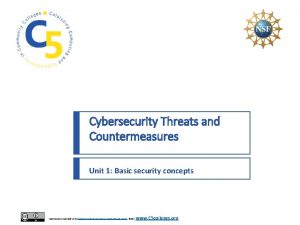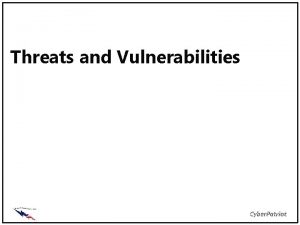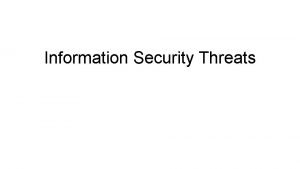System and Network Threats System and Network Threats








- Slides: 8

System and Network Threats

System and Network Threats � � Some systems “open” rather than secure by default � Reduce attack surface � But harder to use, more knowledge needed to administer Network threats harder to detect, prevent � Protection systems weaker � More difficult to have a shared secret on which to base access � No physical limits once system attached to internet � Or on network with system attached to internet � Even determining location of connecting system difficult � IP address is only knowledge

System and Network Threats (Cont. ) � Worms – use spawn mechanism; standalone program � Internet worm � Exploited UNIX networking features (remote access) and bugs in finger and sendmail programs � Exploited trust-relationship mechanism used by rsh to access friendly systems without use of password � Grappling hook program uploaded main worm program � 99 lines of C code � Hooked system then uploaded main code, tried to attack connected systems � Also tried to break into other users accounts on local system via password guessing � If target system already infected, abort, except for every 7 th time

The Morris Internet Worm

System and Network Threats (Cont. ) � Port scanning � Automated attempt to connect to a range of ports on one or a range of IP addresses � Detection of answering service protocol � Detection of OS and version running on system � nmap scans all ports in a given IP range for a response � nessus has a database of protocols and bugs (and exploits) to apply against a system � Frequently launched from zombie systems � To decrease trace-ability

System and Network Threats (Cont. ) � Denial of Service � Overload the targeted computer preventing it from doing any useful work � Distributed denial-of-service (DDOS) come from multiple sites at once � Consider the start of the IP-connection handshake (SYN) � How many started-connections can the OS handle? � Consider traffic to a web site � How can you tell the difference between being a target and being really popular? � Accidental – CS students writing bad fork() code � Purposeful – extortion, punishment

Sobig. F Worm � More modern example � Disguised as a photo uploaded to adult newsgroup via account created with stolen credit card � Targeted Windows systems � Had own SMTP engine to mail itself as attachment to everyone in infect system’s address book � Disguised with innocuous subject lines, looking like it came from someone known � Attachment was executable program that created WINPPR 23. EXE in default Windows system directory Plus the Windows Registry [HKCUSOFTWAREMicrosoftWindowsCurrent. VersionRun] "Tray. X" = %windir%winppr 32. exe /sinc [HKLMSOFTWAREMicrosoftWindowsCurrent. VersionRun] "Tray. X" = %windir%winppr 32. exe /sinc

References � “Operating System Concepts, " by Abraham Silberschatz, et al, 9 th Edition, 2012, John Wiley & Sons Inc. � Operating Systems: A Spiral Approach 1 st Edition by Ramez Elmasri , A Carrick , David Levine
 Modern network security threats
Modern network security threats Computer network threats
Computer network threats Wireless security threats and vulnerabilities
Wireless security threats and vulnerabilities Explain four types of strategies in “swot matrix”
Explain four types of strategies in “swot matrix” Cyber security threats and countermeasures
Cyber security threats and countermeasures Malicious attacks threats and vulnerabilities
Malicious attacks threats and vulnerabilities Factbranch
Factbranch Swot analysis of a teacher
Swot analysis of a teacher Swot analysis example for teachers
Swot analysis example for teachers















